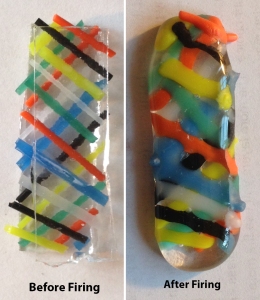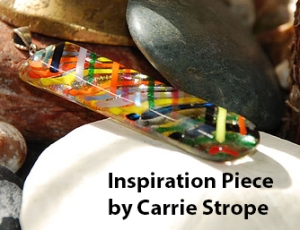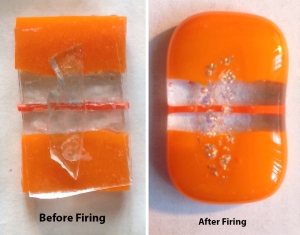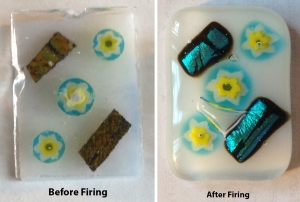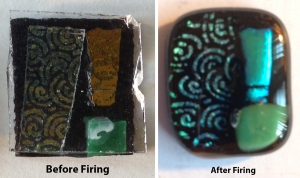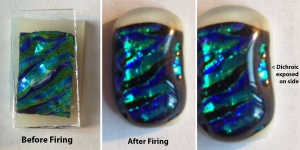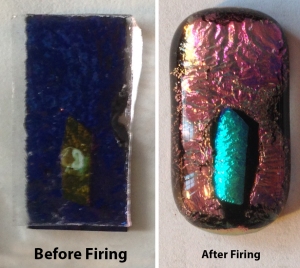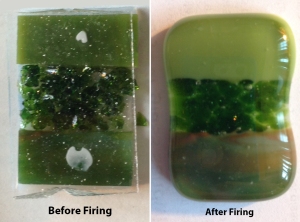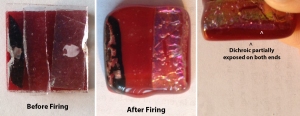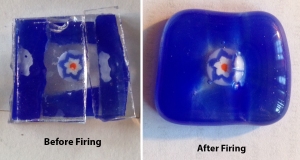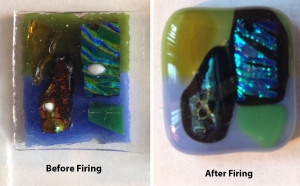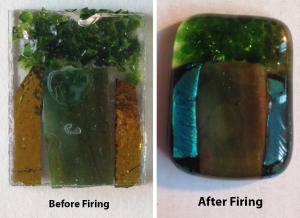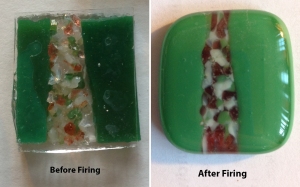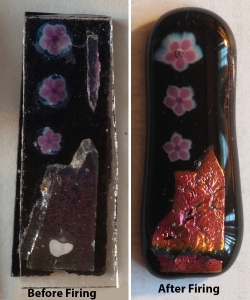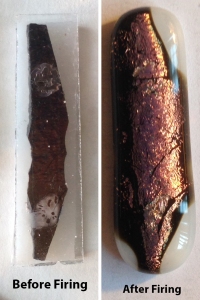So I’ve been experimenting with fusing glass. I have a Paragon SC2 Glass Kiln and I’ve had it a couple of years, but haven’t really used it. I guess I was intimidated by it. I’m still trying to learn about the ramp settings, which to me are very confusing!
Here is the kiln I have (Paragon SC2 with Bead Door and Window):
Here is the firing schedule I used for this batch of glass (COE 90):
Segment Rate Temperature Hold Time (in minutes)
1 400F 1250F 30
2 600F 1480F 10
3 Full 900F 60
4 150F 700F 0 (end)
Now don’t ask me to explain this firing schedule or what any of it means because I really don’t have any idea. I’ve been finding different firing schedules online and trying them hoping to find one that gives me the results I’m looking for.
Here are some pictures of my glass before firing and after firing. Some of the pieces experienced problems during the firing. I will make notations of those things along with the pictures.
This first piece was an epic fail! I saw this picture of a beautiful pendant on Pinterest by Carrie Strope and thought I would try to create something similar. So I layered glass stringers between two pieces of clear glass. As you can see my piece looks NOTHING like the inspiration piece. In fact, my piece didn’t even fully fuse.
This second piece is probably my favorite piece from this batch. It has a base of clear glass. The next layer contains to pieces of orange glass and a piece of glass stringer. The third layer has a piece of clear patterned dichroic glass. Then it is top with another piece of clear glass.
This piece would have been really nice if it weren’t for the huge air bubble between the bottom two flower millifiori. This piece contains some dichroic glass. One thing I love about dichroic (which literally means two colors) is that it reflects different colors when you turn it. However, you never know what color it is going to end up after firing. If you look at the before picture the dichroic glass appears a yellow/orange color and after it was fired it became a beautiful turquoise color. It also contains millifiori (which literally means thousand flowers and is an ancient Italian glass making technique). On this piece I began with a base of white glass. On top of that I placed the three pieces of millifiori and the two pieces of flat dichroic. I topped it off with a piece of clear glass. I’ve since learned that having that much “empty” space on the middle layer is what can cause air bubbles.
This piece came out pretty good. It has a base of black glass followed by two pieces of dichroic and a piece of green opaque glass. I topped it off with a piece of clear glass. Again, notice how that yellow/orange piece of dichroic glass (same kind as in the above piece) turned that beautiful turquoise color.
This piece began with a white base. On top of that I placed a blue-green piece of textured dichroic (on black) glass and then topped it off with a piece of clear glass. There was a slight fusing proglem with piece. If you look in the third picture you’ll see where the clear glass didn’t completely encase the dichroic glass. This probably could have been resolved by using a slightly bigger piece of clear glass.
This next piece really shows dichoric glass at work. I used a piece of flat purple dichroic (on black) glass for the base. On top of that a placed a small piece of that same yellow/orange dichroic and topped it off with a piece of clear glass. The white dot you see in the before picture is just white glue I used to hold the pieces together for transferring to the kiln. I think this piece actually came out quite beautiful with it’s magenta and turquoise colors.
This next piece is a lot different from the ones I’ve shown you so far. I began with a clear base and put two different pieces of green glass on the top and bottom (one was a solid green and the other one was kind of streaked with other colors). In the middle of the two green pieces of glass I put light adventurine green medium frit (which is broken up glass pieces). I then topped it off with clear glass. Again, those white dots you see on the before picture are just white glue, which burns off in the kiln. This piece is more beautiful in real life as the frit and the bottom piece of glass both sparkle, almost as if they contain glitter.
This next piece began with a base of red glass. On top of that I placed a piece of dichroic (on black) and dichroic (on clear) glass at each end. Then I topped it off with scrap clear glass. The scrap pieces of clear glass ended up being a bad choice as it posed a couple problems during the firing process. You’ll notice in the before picture on both the left and right sides there is a little chip in the clear glass pieces. This chip caused the clear glass to not fully enclose the ends of the dichroic glass. Also if you look at the before picture you’ll see that the bottom of the middle piece of clear glass is longer than the two side pieces. If you look at the finished piece you’ll see that middle protrudes a little. I guess this piece was a real learning experience.
This next piece was another learning experience. This piece began with a clear base where I set four pieces of blue transparent glass on top and placed a millifiori in the center and then topped it with scrap clear glass. I was planning on the finished piece to have a clear window in the center showcasing the millifiori, but that was not what I got. The blue glass melted right up to the millifiori. I suppose I should have surrounded the millifiori with clear glass to sort of dam back the blue glass. Also the scrap clear top posed a similar problem as in the piece above. On this piece the problem was where the two pieces of scrap glass met up, but were not flush with each other. In fusing these two pieces the millifiori got distorted.
This next piece did not seem to have any problems. I began with a multi-colored base. I put a green piece and a blue piece of opaque glass together. I got this idea from the Dichroic Glassman on YouTube. I then put two different pieces of textured dichroic glass and two small piece of glass (one amber colored transparent and one green opaque). I topped it off with a piece of clear glass.
This next piece began with a clear base. I then put a piece of that streaked (sparkly) green glass in the middle, with two pieces of the orange/yellow textured dichroic on either side. At the top I used the light adventurine green medium frit again. This piece fired nicely without any problems. Again in real life the frit and the middle piece really sparkle.
This next piece is probably my second favorite piece out of this batch. It began with a clear base. I then put two pieces of green opaque glass on either side. The middle I filled with frit (Sushi color blend) and top the piece with clear glass. It think this piece turned out beautiful.
This next piece began with a black base. I then put three millifiori in varying sizes down from the top. I put a sliver of flat dichroic glass on the right of the millifiori and a piece of the same color down at the bottom. I then topped it off with clear glass. The dichroic is actually more pink than red in real life. The little sliver actually melted over to the side so you really can’t see it in the finished piece.
This final piece of glass began with a white base of which I put a piece of flat dichroic (on black) glass on top followed by a clear piece of glass. I was kind of surprised how much the piece of dichroic glass expanded over the top of the piece of white glass. I thought more white glass would be showing through in the finished piece. Other than my expectations, the piece fired just fine.
So if their are any fused glass artists out there reading my blog, I would welcome any tips and advice you could give to this novice glass fuser.
Which piece is your favorite out of the batch?


